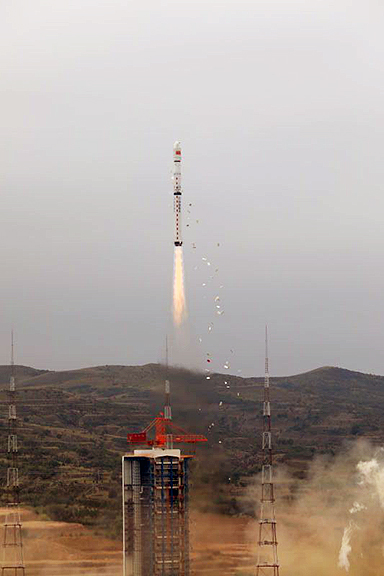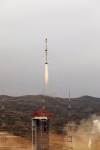China delivered a resource satellite and two small satellites into planned orbits from the Taiyuan Satellite Launch Center in north China’s Shanxi Province on Thursday, September 12 — they were launched on a Long March-4B carrier rocket at 11:26 a.m., Beijing Time.

The Long March-4B carrier rocket of China’s ZY-1 02D satellite and two smallsats.
Photo is courtesy of chinaplus.cri.cn.
The resource satellite, ZY-1 02D, was developed by the China Academy of Space Technology (CAST) and is an important part of China’s space-based infrastructure. It will provide observation data for natural resources asset management, ecological monitoring, disaster prevention and control, environmental protection, urban construction, transportation and contingency management. With an expected lifespan of five years, ZY-1 02D will form a network, with more satellites to follow.
ZY-1 02D will work in the solar synchronous orbit at 778 km. above the Earth. It carries a near-infrared camera with a coverage width of 115 km., enabling it to observe large and medium-sized cities and to be used for urban planning, said the satellite’s project manager, Li Yifan. It also carries a 166-band hyperspectral camera that can produce 166 pictures with different color bands, simultaneously. The camera can capture the reflected light information of various minerals, and be used to analyze complicated mineral compositions and distribution, said Li. The satellite can also be used to observe chlorophyll concentration, water transparency and total suspended matter concentration in lakes to help monitor the environment and prevent water pollution.
One of the two smallsats launched on the same rocket belongs to Beijing Normal University and is named BNU-1 — the second smallsat belongs to a Shanghai-based private space technology company. Both have an expected lifespan of one year.
BNU-1, developed by a Shenzhen-based company affiliated to CAST, weighs about 16 kg. and will be mainly used to monitor polar climate and environment, greatly helping research of the polar regions and global climate change. The satellite can report sea ice changes, which could help with ship navigation and make channel risk assessments.
Thursday’s launch is the 310th mission of the Long March carrier rocket series.
Article source: Xinhua

For all involved in the satellite and space industry and the various market segments that add value to these dynamic environments, the 2020 SmallSat Symposium is truly worth your consideration for attendance.
The SmallSat Symposium is hosted by Satnews Publishers which, since 1983, has been a provider of a satellite news, media and events. This information packed forum was created to enable you and your company to secure a larger portion of market share as well as to take part in the next stages of your company’s or organization’s growth.

The personal connections at the SmallSat Symposium enable attendees to network with established organizations, subject-matter experts as well as ‘New Space’ entrants.
The SmallSat Symposium will focus on new technologies and the business environment that is shaping the implementation of smallsat constellations, smallsat launchers, the challenges facing the smallsat developer and actors as well as the enormous benefits of these advanced technologies that will benefit our world.
This event assembles more than 100 diverse speakers, all of whom possess deep industry experience. Additionally, numerous opportunities exist to mingle and network with peers while enjoying exceptional, complimentary meals and refreshment breakfast.

